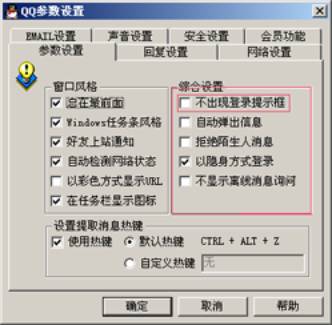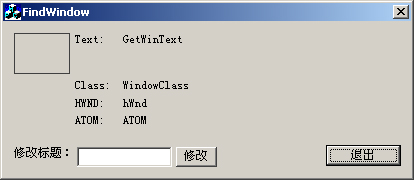大家都用過Vc自代的工具Spy++,它可以通過鼠標來捕捉窗口,得到窗口的信息。
在MSDN裡面找到了一個相關的API:RealChildWindowFromPoint:
HWND RealChildWindowFromPoint(正如Msdn所說的,RealChildWindowFromPoint函數只能夠查找到由 ptParentClientCoords 所得到的子窗口,而無法得到真正指向最“深層”的窗口,也就是說如果有兩個窗口重疊,就無法得到下面的窗口,這樣的情況是經常出現的(如圖一所示)。
HWND hwndParent, // handle to window
POINT ptParentClientCoords // client coordinates
);
The RealChildWindowFromPoint function retrieves a handle to the child window at the
specified point. The search is restricted to immediate child windows; grandchildren
and deeper descendant windows are not searched.

圖一
(這兩個紅框框起來的窗口就重疊了,如果用 RealChildWindowFromPoint 就只能得到綜合設置的窗口,而無法的到“不出現登陸提示框”的復選框)。所以你只簡單的調用這個函數是無法實現Spy++的功能的。
下面的這個函數就可以取得最“深層”的窗口,實現Spy++的功能。 #define ZOU_PROCESS_ERROR(condition)
if(!(condition))
goto Exit0; //錯誤處理宏定義
int CGetWindowInfo::GetRealWindow(HWND *phWnd, POINT ptPoint)
{
int nResult = false;
int nRetCode = false;
HWND hWndTop = NULL;
HWND hWndChild = NULL;
POINT ptCooChild = {0};
LONG lWindowStyle = 0;
//先得到ptPoint指向的(子)窗口
hWndTop = ::WindowFromPoint(ptPoint);
ZOU_PROCESS_ERROR(hWndTop);
ptCooChild = ptPoint;
lWindowStyle = GetWindowLong(hWndTop, GWL_STYLE);
//通過這個判斷找到最上層的父窗口(也就是上面圖片中“QQ設置”的主窗口)
if( !GetParent(hWndTop) ||
GetDesktopWindow() == GetParent(hWndTop) ||
!(lWindowStyle & WS_CHILDWINDOW))
{
*phWnd = hWndTop;
}
else
{
*phWnd = GetParent(hWndTop);
}
// 轉換相對坐標
::ScreenToClient(*phWnd, &ptCooChild);
//從父窗口一層一層往下查找子窗口,直到找到最底層的子窗口
while (TRUE){
hWndChild = RealChildWindowFromPoint(*phWnd, ptCooChild);
if (hWndChild && (hWndChild != *phWnd))
*phWnd = hWndChild;
else
break;
}
nResult = true;
Exit0:
return nResult;
}
通過先找父窗口,然後一直向下直到找到子窗口,得到它的句柄。得到句柄以後,就可以對這個窗口做許多事情了。我在附上的源代碼中實現了修改窗口文字的功能(程序畫面如圖二)。

圖二
希望對您有所啟發和幫助。
本文配套源碼